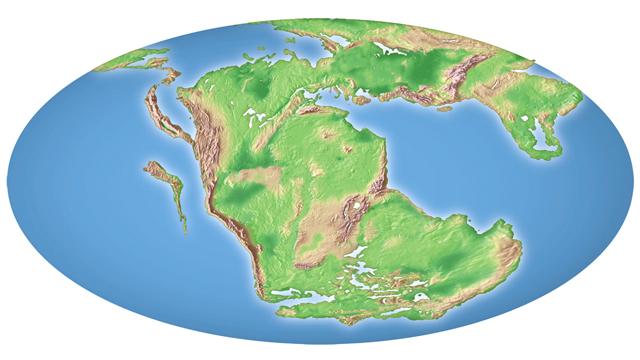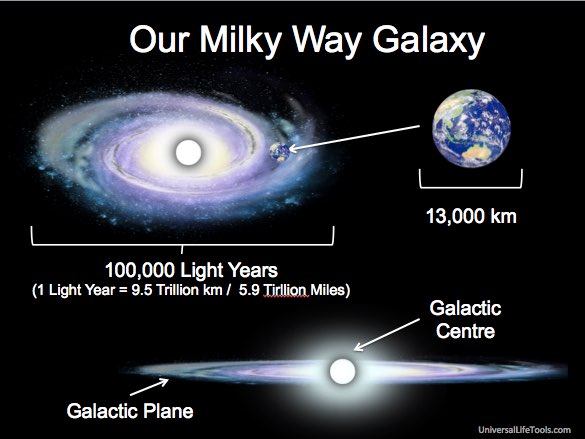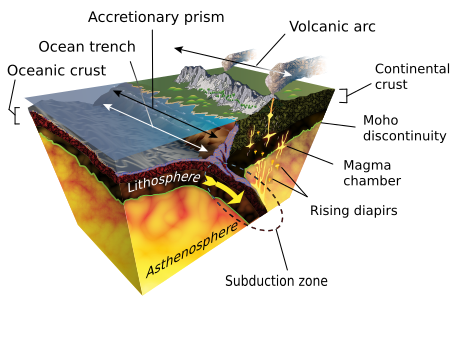It looks like you're using an Ad Blocker.
Please white-list or disable AboveTopSecret.com in your ad-blocking tool.
Thank you.
Some features of ATS will be disabled while you continue to use an ad-blocker.
10
share:
Pangaea is said to of formed and separated into the continents of today approximately or near one galactic year ago...

Pangaea (sometimes spelled Pangea), the most recent of a series of supercontinents
on Earth, formed about 270 million years ago and broke apart about 200 million years ago. At this time most of the dry land on Earth was joined into one huge landmass that covered nearly a third of the planet's surface. The giant ocean that surrounded the continent is known as Panthalassa.
The movement of Earth's tectonic plates formed Pangaea and ultimately broke it apart.
Pangaea existed during the Permian and Triassic geological time periods, which were times of great change. The Permian mass extinction, which wiped out an estimated 96% species about 248 million years ago, was a major event during this time.
www.bbc.co.uk...

en.m.wikipedia.org...
Continue/

Pangaea (sometimes spelled Pangea), the most recent of a series of supercontinents
on Earth, formed about 270 million years ago and broke apart about 200 million years ago. At this time most of the dry land on Earth was joined into one huge landmass that covered nearly a third of the planet's surface. The giant ocean that surrounded the continent is known as Panthalassa.
The movement of Earth's tectonic plates formed Pangaea and ultimately broke it apart.
Pangaea existed during the Permian and Triassic geological time periods, which were times of great change. The Permian mass extinction, which wiped out an estimated 96% species about 248 million years ago, was a major event during this time.
www.bbc.co.uk...

The galactic year, also known as a cosmic year, is the duration of time required for the Sun to orbit once around the center of the Milky Way Galaxy.[1]Estimates of the length of one orbit range from 225 to 250 million terrestrial years.
en.m.wikipedia.org...
Continue/
a) Is it possible similar changes may take affect on EA*RTH and within the SOL system as the galactic year nears or passes?
b) Is it possible that Celestial objects orbital paths encounter the SOL system galactic path & its planet bodies during the nearing or passing of the Actual not Approximate galactic year?
c) Are some of these celestial objects and their paths of orbit, responsible for physical changes to the main star and the planets orbiting it?
Physical changes such as increased tectonic activity, pole shifts to planets and increased or decreased star activity.
b) Is it possible that Celestial objects orbital paths encounter the SOL system galactic path & its planet bodies during the nearing or passing of the Actual not Approximate galactic year?
c) Are some of these celestial objects and their paths of orbit, responsible for physical changes to the main star and the planets orbiting it?
Physical changes such as increased tectonic activity, pole shifts to planets and increased or decreased star activity.
a reply to: Ophiuchus 13
Great questions, and I love this topic.
The downside to researching any of this is obvious though. We can't do much more than speculate, considering it is the first time around for all of us.
So much we don't know yet and can't see. It's an amazing ride though when we keep things in perspective the best we can.
Wish I could add more but it would all be speculative.
S&F for sparking a good conversation. I'll be back to this thread later.
Great questions, and I love this topic.
The downside to researching any of this is obvious though. We can't do much more than speculate, considering it is the first time around for all of us.
So much we don't know yet and can't see. It's an amazing ride though when we keep things in perspective the best we can.
Wish I could add more but it would all be speculative.
S&F for sparking a good conversation. I'll be back to this thread later.
Outta box
Can a companion of the Star SOL located in the current region of the Milky way galaxy be responsible for the movements of new Celestial objects such as new found planets or moons into the outer Solsystem?
This thread was generated as 1 was considering the formation of Super continent Pangaea and those Super continents Rodinia and Gondwana formed before it, postulating if new continent forming or changes may occur soon or in the near future...
news.nationalgeographic.com...
Thanks for you mind time for any who answer and review the questions.
NAMASTE*******
Can a companion of the Star SOL located in the current region of the Milky way galaxy be responsible for the movements of new Celestial objects such as new found planets or moons into the outer Solsystem?
This thread was generated as 1 was considering the formation of Super continent Pangaea and those Super continents Rodinia and Gondwana formed before it, postulating if new continent forming or changes may occur soon or in the near future...
Matching up rock types, examining magnetic signatures, and cataloging fossils have allowed scientists to trace the cycle of supercontinents forming and breaking apart back at least a billion years. Earth is believed to be about 4.5 billion years old.
The data show there were two supercontinents before Pangaea called Rodinia and Gondwana that formed and broke up hundreds of millions of years ago.
news.nationalgeographic.com...
Thanks for you mind time for any who answer and review the questions.
NAMASTE*******
I always sort of thought the continents spread because the earth grew in size. How smaller was earths diameter "two hundred million years ago" ?
The whole big continent thing flies against the science of plate tectonics; subduction and sea floor spreading is round the world, not just in one place.
The whole big continent thing flies against the science of plate tectonics; subduction and sea floor spreading is round the world, not just in one place.
a reply to: intrptr
I'm not sure where the added mass would come from if the mass of the planet changed its size.
It seems like the planet recycles its land and seas.
In theory the planet continent crust is basically absorbed and the lithosphere pushes new land up from below. Recycling replenishing the planet.

But are there changes in the cosmos that agitate these processes?
I'm not sure where the added mass would come from if the mass of the planet changed its size.
It seems like the planet recycles its land and seas.
In theory the planet continent crust is basically absorbed and the lithosphere pushes new land up from below. Recycling replenishing the planet.

But are there changes in the cosmos that agitate these processes?
the Galaxy rotation has very little to do with the tectonic plates slow or fast movement
however, as the Solar System orbits the Galactic Center, the Spiral Arm where our Solar System sits does undulate up-&-down at something like 50 million years 'wave'
When the Solar System gets to the Top-of-the-Wave cycle... various energies/gamma-rays/etc. penetrate the Heliosphere and hit the Earth causing a multi-million year increase of Radiation to affect our DNA, destroying & altering our Genes, Etc.
There are some very exotic subatomic particles/high-energy cosmic rays... which also penetrate the Earth and may even cause the Earth Core & Mantle to become agitated with mini explosions (sorry I forgot the name of these high energy Rays)
see: www.space.com...
the result of overheating the interior Mantle Convection Current, must inevitably lead to extreme Vulcanism all over the Earth's Tectonic Plate Boundaries --- ergo swift plate shifting such as the merging or spreading of the land surfaces in the Oceanic basins of the planet
however, as the Solar System orbits the Galactic Center, the Spiral Arm where our Solar System sits does undulate up-&-down at something like 50 million years 'wave'
When the Solar System gets to the Top-of-the-Wave cycle... various energies/gamma-rays/etc. penetrate the Heliosphere and hit the Earth causing a multi-million year increase of Radiation to affect our DNA, destroying & altering our Genes, Etc.
There are some very exotic subatomic particles/high-energy cosmic rays... which also penetrate the Earth and may even cause the Earth Core & Mantle to become agitated with mini explosions (sorry I forgot the name of these high energy Rays)
see: www.space.com...
the result of overheating the interior Mantle Convection Current, must inevitably lead to extreme Vulcanism all over the Earth's Tectonic Plate Boundaries --- ergo swift plate shifting such as the merging or spreading of the land surfaces in the Oceanic basins of the planet
originally posted by: Ophiuchus 13
a reply to: intrptr
I'm not sure where the added mass would come from if the mass of the planet changed its size.
It seems like the planet recycles its land and seas.
In theory the planet continent crust is basically absorbed and the lithosphere pushes new land up from below. Recycling replenishing the planet.
But are there changes in the cosmos that agitate these processes?
No, the mass of the earth is sufficient to maintain a molten core due to gravitational pressure. That heat energy rises to the surface and returns to the depths in a process known as convection. The continental plates ride on that molten sea, like shown in the video below.
The added mass of earth overall comes over time from the cosmos. A fine dust of meteorites, thousands of tons worth(?) rains down on earth every day. I don't feel like doing the math.
a reply to: Ophiuchus 13
I checked, seems I over-guess-timated. Link below.
The rain of cosmic dust is heavier the father back we go in time. Gets 'augmented' from time to time with large impactors. The Moon itself is thought to be the result of one such uuuge impact event.
Talk about recycle.
NASA
I checked, seems I over-guess-timated. Link below.
The rain of cosmic dust is heavier the father back we go in time. Gets 'augmented' from time to time with large impactors. The Moon itself is thought to be the result of one such uuuge impact event.
Talk about recycle.
NASA
new topics
-
Remember These Attacks When President Trump 2.0 Vengeance-Retribution Commences.
2024 Elections: 15 minutes ago -
Predicting The Future: The Satanic Temple v. Florida
Conspiracies in Religions: 23 minutes ago -
WF Killer Patents & Secret Science Vol. 1 | Free Energy & Anti-Gravity Cover-Ups
General Conspiracies: 2 hours ago -
Hurt my hip; should I go see a Doctor
General Chit Chat: 3 hours ago -
Israel attacking Iran again.
Middle East Issues: 4 hours ago -
Michigan school district cancels lesson on gender identity and pronouns after backlash
Education and Media: 4 hours ago -
When an Angel gets his or her wings
Religion, Faith, And Theology: 5 hours ago -
Comparing the theology of Paul and Hebrews
Religion, Faith, And Theology: 6 hours ago -
Pentagon acknowledges secret UFO project, the Kona Blue program | Vargas Reports
Aliens and UFOs: 7 hours ago -
Boston Dynamics say Farewell to Atlas
Science & Technology: 7 hours ago
top topics
-
The Democrats Take Control the House - Look what happened while you were sleeping
US Political Madness: 10 hours ago, 18 flags -
In an Historic First, In N Out Burger Permanently Closes a Location
Mainstream News: 12 hours ago, 16 flags -
A man of the people
Medical Issues & Conspiracies: 17 hours ago, 11 flags -
Man sets himself on fire outside Donald Trump trial
Mainstream News: 9 hours ago, 9 flags -
Biden says little kids flip him the bird all the time.
Politicians & People: 9 hours ago, 9 flags -
Michigan school district cancels lesson on gender identity and pronouns after backlash
Education and Media: 4 hours ago, 7 flags -
Pentagon acknowledges secret UFO project, the Kona Blue program | Vargas Reports
Aliens and UFOs: 7 hours ago, 6 flags -
WF Killer Patents & Secret Science Vol. 1 | Free Energy & Anti-Gravity Cover-Ups
General Conspiracies: 2 hours ago, 6 flags -
Israel attacking Iran again.
Middle East Issues: 4 hours ago, 5 flags -
Boston Dynamics say Farewell to Atlas
Science & Technology: 7 hours ago, 4 flags
active topics
-
Remember These Attacks When President Trump 2.0 Vengeance-Retribution Commences.
2024 Elections • 3 • : KrustyKrab -
Michigan school district cancels lesson on gender identity and pronouns after backlash
Education and Media • 9 • : TheMisguidedAngel -
Predicting The Future: The Satanic Temple v. Florida
Conspiracies in Religions • 3 • : Vermilion -
Mood Music Part VI
Music • 3064 • : MRTrismegistus -
Man sets himself on fire outside Donald Trump trial
Mainstream News • 41 • : TheMisguidedAngel -
The New, New ATS Members Photos thread. Part 3.
Members • 1653 • : zosimov -
A man of the people
Medical Issues & Conspiracies • 15 • : PrivateAngel -
Israel attacking Iran again.
Middle East Issues • 27 • : KrustyKrab -
I hate dreaming
Rant • 7 • : TheMichiganSwampBuck -
MULTIPLE SKYMASTER MESSAGES GOING OUT
World War Three • 53 • : Zaphod58
10
